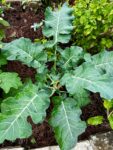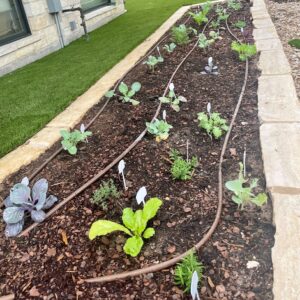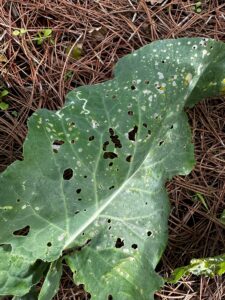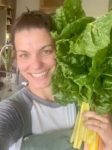December Vegetable Garden Checklist by Paula Wolfel

Broccoli growing next to a basil plant that is holding on from the summer garden.
The short lived cold front that passed through a few weeks ago definitely teased Austinites. My basil plants took a beating and my summer squash, cucumbers, and tomatoes that were already struggling from the drought did not survive. But my eggplant and peppers are still going strong, so I face the struggle of every Austin gardener: when do you call it quits and move on to the next season!? Hopefully by now you have your brassicas, root vegetables, and leafy greens planted and you are preparing your garden for the impending cold.
Let’s Talk Brassicas
Brassica vegetables are part of the genus Brassicaceae, or mustard family. They are also knowns as the cruciferous vegetables, or Cruciferae, meaning “cross-bearing,” describing the four petals of mustard flowers, which resemble a cross. They are also commonly referred to as cole crops. The family contains over 4,000 species. Many of the members of the brassica family originated from wild cabbage and evolved over thousands of years.
The brassicas that grow in the Austin garden are broccoli, Brussel sprouts, cabbage, Chinese cabbage, cauliflower, turnips, radish, kohlrabi, kale, bok choy, collard greens, watercress, arugula, mustard greens, and nasturtium. If you are trying these crops out for the first time, the leafy members and broccoli are the easiest to grow and will give repeated harvests. Brussel sprouts and cauliflower are the hardest to grow. You’ll find more success by growing or purchasing transplants rather than direct seeding into your garden. This mostly has to do with soil temperature – they germinate better in cooler soils. They do best in full sunlight and in soil with lots of organic material. Pay attention to spacing requirements for any brassica not grown strickly for greens. They grow well alongside onions, leeks, garlic, carrots, beets, lettuce, arugula, spinach, marigolds, borage, nasturtium, thyme, sage, oregano, and chives.
December Vegetable Garden Checklist
Enjoy the cooler weather with these jobs you can do in your December vegetable garden:
FERTILIZE
- Continue to feed vegetables with fish emulsion or other water-soluble fertilizers every two weeks.
WATER
- Irrigate only if the soil is dry a few inches below the surface or in newly established seedbeds. We have been lucky with some good rain this fall. So continue to keep an eye on the weather forecast and remember, your plants prefer rain water.
SOIL
- If you chose not to have a winter garden, continue to use mulch to protect your soil and keep it healthy for the spring.
WHAT TO PLANT
-

An early-December Austin brassica garden
Seed or transplant hardy winter greens into the vegetable garden and be prepared to protect during a frost.
- Grow indoors, seedlings of broccoli, cabbage, cauliflower, bok choy, mustard, chard, or other greens so you will have a continual supply of transplants for setting out in January and February. Plan accordingly because it takes 5-6 weeks to reach transplant size.
- You may also consider starting your tomatoes indoors so they are ready to transplant early to mid-March.
- Plant cool season herbs in place of your basil, such as thyme, oregano, sage, chives, parsley, and cilantro.
Seeds
- Greens, cool season (all month)
- Radishes (all month)
Transplants
- Asian Greens (all month)
- Lettuce (all month)
- Spinach (all month)
Seeds or Transplants:
- Asian Greens (all month)
- Lettuce (all month)
- Spinach (all month)
DISEASES AND PESTS TO LOOK FOR

Cabbage looper holes and leaf miner damage
- Cabbage loopers are the most common pest this time of year. They are found on all members of the brassica family. You can keep row covers on your plants to prevent cabbage loopers or treat with Bt (Bacillus thuringiensis).
- Aphids, snails/slugs, and leaf miners are also present in the garden.
MAINTENANCE
- Keep up with weeds while they are young and before they have a chance to put down roots.
- Take advantage of mild winter days to tidy up your shed and greenhouse. Disconnect hoses, and put away tools before cold weather arrives.
- Pull or cut down weeds before the go to seed.
- Keep an eye on the forecast and have your frost cover ready for when temperatures dip.
HARVEST
- Enjoy a supply of fresh salad greens by harvesting young leaves of lettuce, kale and spinach. This is when the leaves are small and tender, and have the sweetest flavor. Regular harvesting will stimulate plants to produce more leaves.
Thinking Ahead: Preparation for the First Frost
As a reminder, in preparation for freezing temperatures, make sure you mulch around all your plants and keep bare soil covered with mulch or leaves.
If a freeze is expected:
- Water plants beforehand.
- Cover newly planted plants, and tender vegetables and landscape plants with row cover, sheets or blankets making sure to secure the fabric to the ground to prevent wind from blowing it up and to seal in heat from the ground.
- Disconnect hoses, wrap faucets, and drain sprinklers before the freezing night arrives.
Additional Resources
Watch the Vegetable Gardening in Central Texas Webinar
Vegetable Planting Calendar (Español, 繁体中文)
Recommended Vegetable Varieties for Travis County
Easy Gardening Series Detailed tips from Texas A&M University AgriLife Extension on specific crops and practices.
Vegetable Gardening in Austin Resource hub for all things vegetables for Travis County
Plant Rotations, Successions and Intercropping
Monthly Gardening Calendar for Austin and Central Texas
Sustainable Food Center Farmers Markets
About Paula Wolfel
 Paula Wolfel joined the Travis County Master Gardener program in 2022, but has been gardening in Austin, Texas since 2017. She grew up in the suburbs of Chicago learning how to garden from both her father—a Sicilian vegetable and fruit tree gardener—and both her grandmothers, and then spent years in Virginia gardening. Paula loves gardening because she finds it to be a grounding force- it gets her out of her head and into the present. She loves the pride that comes with cooking a meal for her family with every ingredient coming from her garden… and then the humility she feels when she loses an entire crop because of Mother Nature. She finds gardening to be wisdom, lessons, best practices passed down generation to generation, season to season and hopes to share that with you.
Paula Wolfel joined the Travis County Master Gardener program in 2022, but has been gardening in Austin, Texas since 2017. She grew up in the suburbs of Chicago learning how to garden from both her father—a Sicilian vegetable and fruit tree gardener—and both her grandmothers, and then spent years in Virginia gardening. Paula loves gardening because she finds it to be a grounding force- it gets her out of her head and into the present. She loves the pride that comes with cooking a meal for her family with every ingredient coming from her garden… and then the humility she feels when she loses an entire crop because of Mother Nature. She finds gardening to be wisdom, lessons, best practices passed down generation to generation, season to season and hopes to share that with you.
